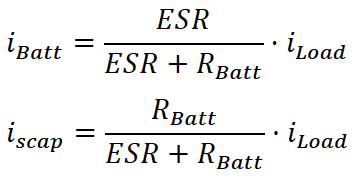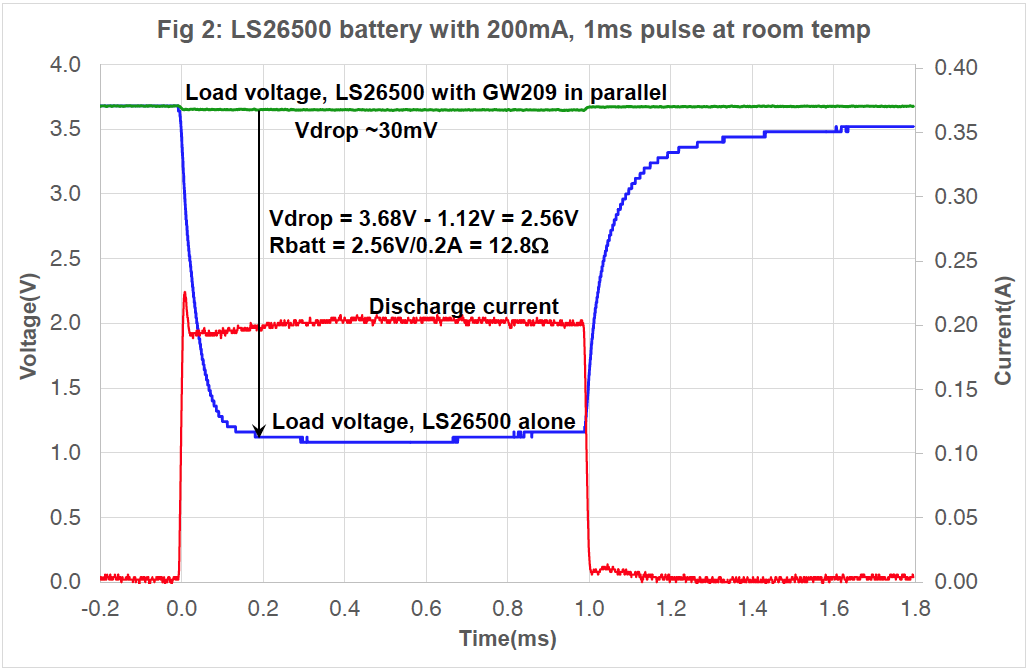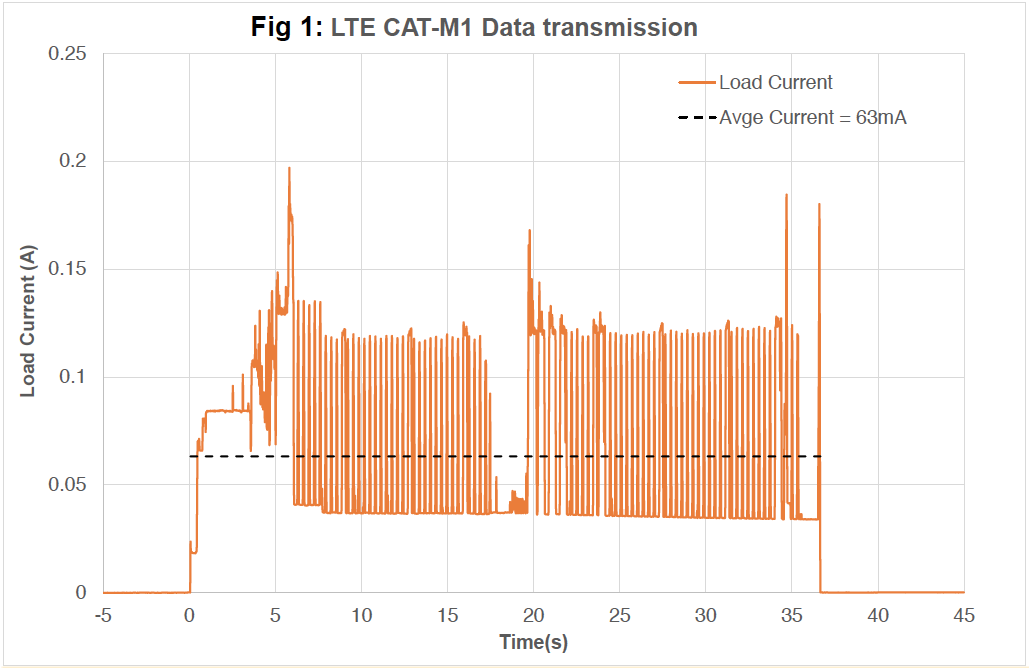Supercapacitors provide battery support
Batteries are often used to supply units that are autonomously powered, from utility meters to key fobs and IoT wearables. These applications often have peak power needs can only be met with a supercapacitor.
Supercapacitors deliver peak power to support batteries.
Applications that are autonomously powered must use an energy harvester and / or battery. Where primary batteries are used they need to be high energy and low self discharge for the unit to have a long life. Examples are Lithium Thionyl Chloride batteries, used to power utility meters for up to 15 years, and CR2032 batteries in car key fobs and wearables. Batteries, which store energy electrochemically, are limited by the rate of the chemical reaction for the power they can deliver. This is exacerbated at cold temperatures such as outdoors in a North American or European winter. A short peak power is required to transmit data. This limited power delivery manifests itself as relatively high internal impedance, Rbatt, e.g. a CR2032 will typically be ~5 – 10Ω, a 7.7Ah Lithium Thionyl Chloride battery has internal impedance ~4.5Ω. A GS230 1.2F CAP-XX supercapacitor has Equivalent Series Resistance (ESR) of 25mΩ. Placing this supercapacitor across the battery means the supercapacitor will deliver nearly all the peak current – the current will be split between the battery and supercapacitor as a ratio of 1/ESR:1/Rbatt, so with the Lithium Thionyl Chloride battery, the supercapacitor will deliver over 99% of the current. CAP-XX offers solutions if the inrush current to charge the supercapacitor needs to be limited.
APPLICATON BRIEF
AB1004 Rev 3.4
Supercapacitors Provide Battery Support
In many battery powered applications, short bursts of peak power are required to collect and transmit data or to drive an actuator. Examples include utility meters, key fobs and IoT wearables. Batteries often have difficulty delivering this power with a large voltage drop due to their internal resistance, especially in cold northern winters. Supercapacitors, with low equivalent series resistance in the 10’s – 100’s of mΩ down to -40°C can support batteries to deliver the power required.
Peak Power Needs
Batteries store energy electrochemically, so the power they can deliver is limited by the rate of the chemical reaction. Many battery powered applications require a peak power burst to collect and transmit data. Examples include a utility meter reporting data over the cellular network, a key fob transmitting to unlock a car door, wearables reporting over BLE or alerting a user with vibration. A cellular call using the new low power NB IoT standard for data transmission draws ~60mA average current and ~200mA peak current, see Fig 1. Depending on the location of the nearest cellular tower, peal current during Tx could reach ~500mA. An 8Ah LS26500 LiSOCl2 battery has an internal resistance, Rbatt, of 12.8Ω supplying 200mA, see Fig 2. It suffers a voltage droop of ~2.6V in supplying 200mA and cannot not supply 500mA. Similarly, a CR2032 battery, commonly used in key fobs and wearables has Rbatt ~10Ω. The Spire e-health tag provides a vibration alert to the wearer. This requires an initial starting current of ~120mA, which would drop the battery voltage by ~1.2V causing an under-voltage shutdown of the unit. Bluetooth Low Energy requires transmit currents of up to 10mA which results in a voltage droop of ~100mV. This means the unit will shut down during transmission due to the voltage droop, even though there is plenty of energy left in the battery. A supercapacitor can extend battery life by preventing this premature shutdown.
Supercapacitors complement batteries
Supercapacitors, like traditional capacitors have physical charge storage so are not limited in power by the rate of a chemical reaction as in a battery. They can deliver 100’s – 1000’s times more power than a battery and have Equivalent Series Resistance (ESR) typically in the 10’s – 100’s of mΩ range. Large traditional capacitors are typically the 100’s of µF range, while supercapacitors store ~1000 x more energy with capacitance in the Farad range. When placed across a battery this allows them to deliver the peak power for the duration required.
The supercapacitor is an ideal power buffer, charged by the battery at average load current and delivering periodic or sporadic bursts of peak current.
The other key attribute of CAP-XX supercapacitors that make them ideal to place across a battery is low leakage current (IL), ~1µA/F. Therefore, the GW209 part across a LiSOCl2 battery in Fig 2 has a typical IL of ~0.5µA. Leakage current is drawn from the battery continuously so it can be a significant drain on energy. With only 0.5µA IL, a GW209 only draws 4.4mAh/yr.
Supercapacitor / Battery current split
The supercapacitor and battery will share load current as:

Refer to Coupling a Supercapacitor with a Battery.
In the case of a GW209 (ESR = 55mΩ) across an LS26500 battery (Rbatt = 12.8Ω), the GW209 provides 99% of the current. Fig 2 shows this with a GW209 supercap across an LS26500 battery reducing the battery voltage drop from 2.56V to ~30mV at room temperature. Note that Rbatt is not constant and increases with load current.

Inrush Current Limiting
A CAP-XX supercapacitor, with its very low ESR, will try to draw very high inrush current when initially charging from 0V. In many cases the battery’s internal impedance will act as a sufficient current limit, but if inrush current limiting is required to protect the battery, then see Current Limiting for Supercapacitors.
Selecting your Supercapacitor
If using a 3V battery, then you can use a single 3V cylindrical cell, GY13R0 series, or a 2.75V prismatic cell from our H series. The HA102 and HA130 fit over a CR2032 coin cell. If using a 2.75V cell, then a low power regulator is required between the battery and supercap, see Coupling a Supercapacitor with a Battery. If you are using a higher voltage battery, then a dual cell supercap is required with active balancing to minimise energy drain from the battery, see Cell Balancing. Our latest range of prismatic dual cell supercaps cover every application, with DMF for very high power, DMT for very long life and up to 85°C operation, and the ultra-thin DMH ideal with a coin cell in wearables. The supercap must have low enough ESR and high enough C at end of life to support the peak pulse load, refer to Powering Pulsed Loads.



